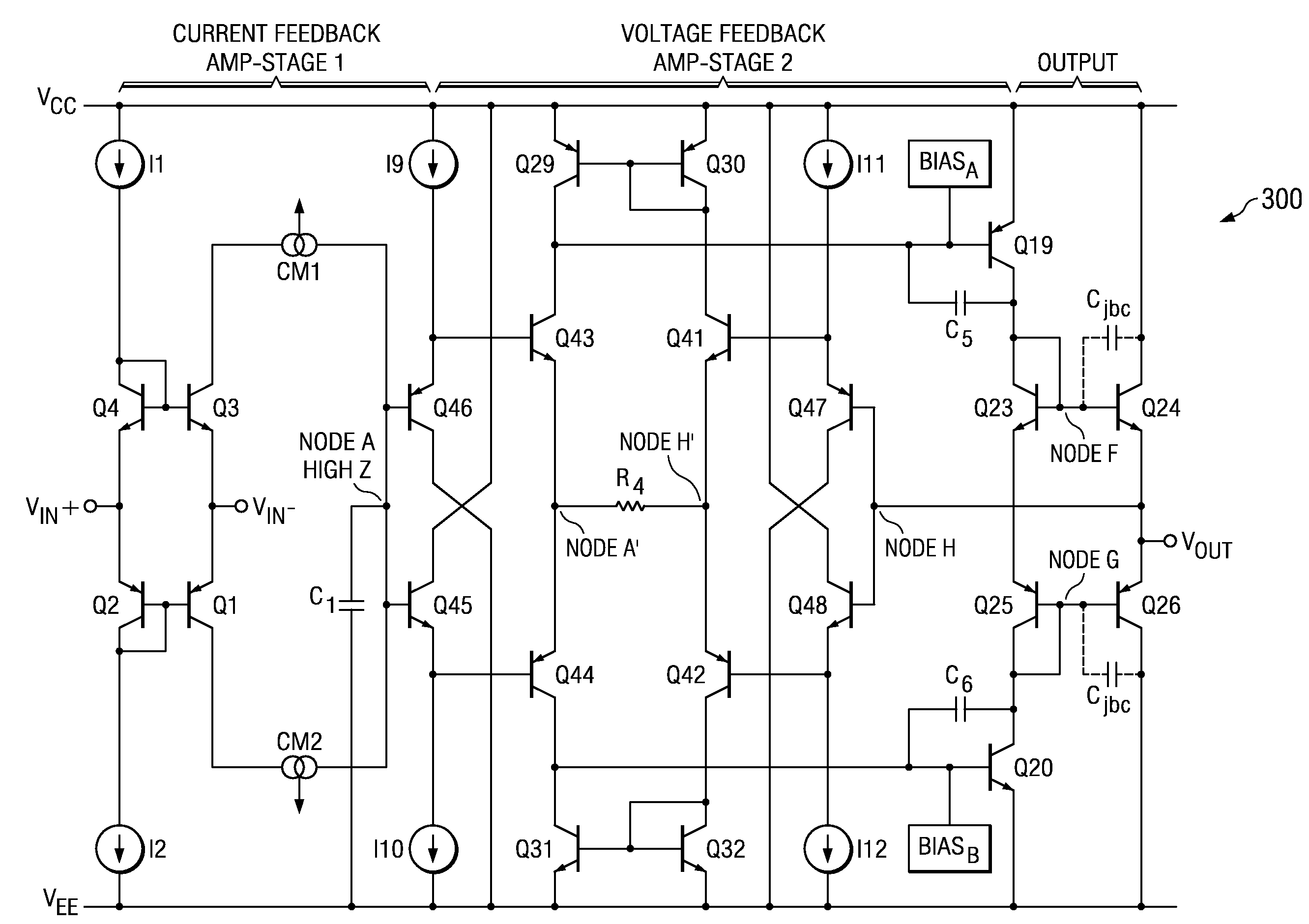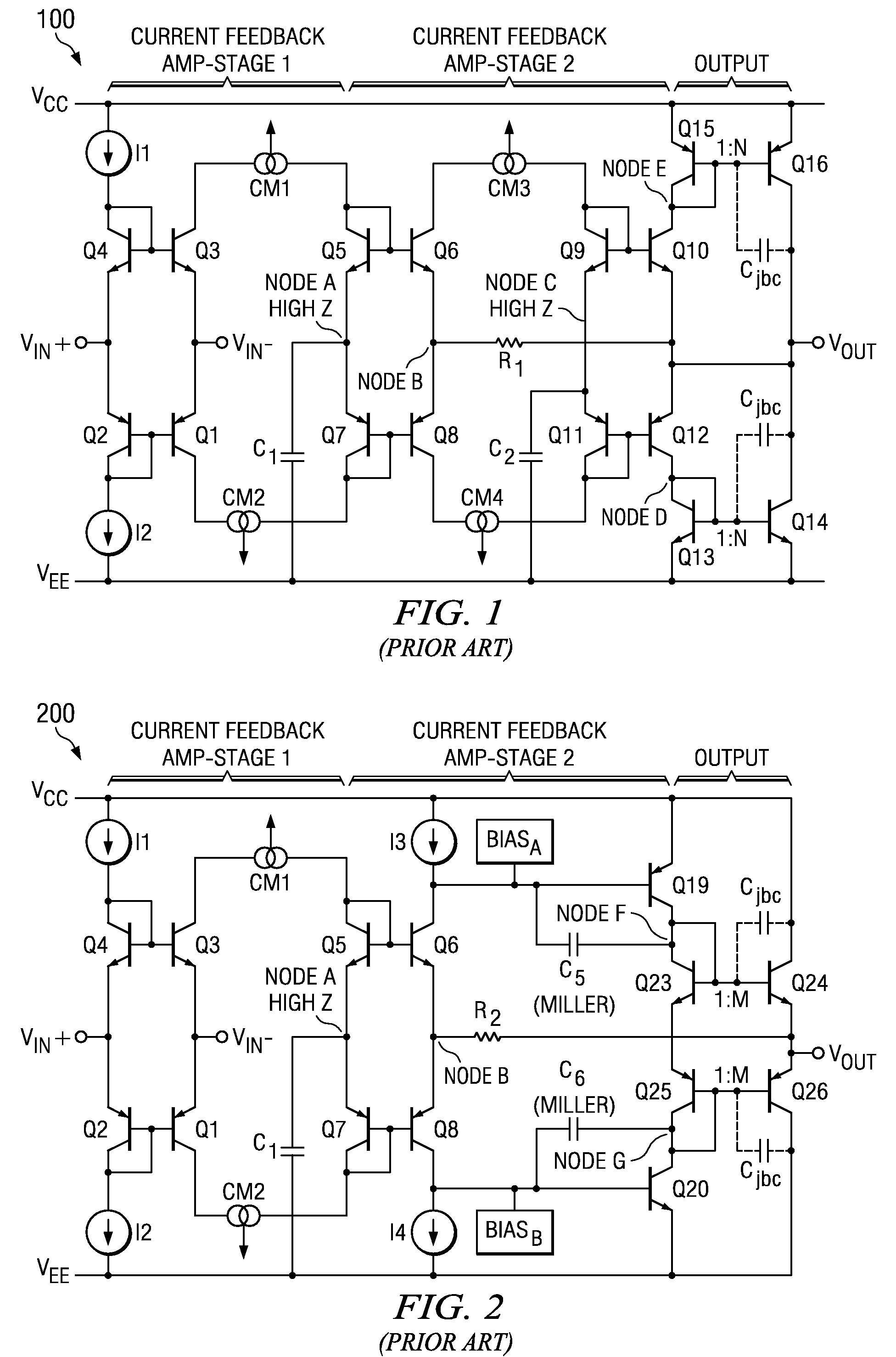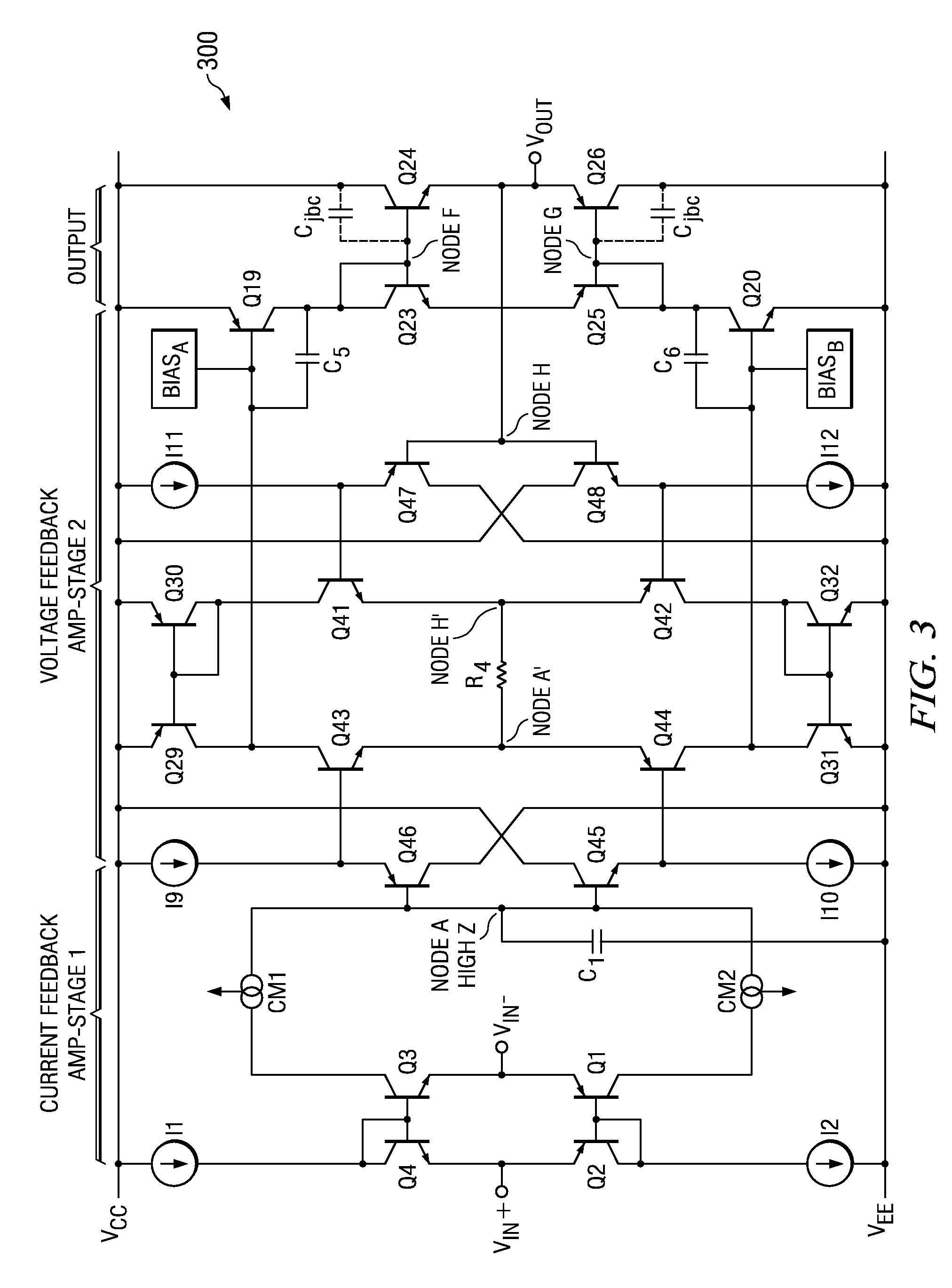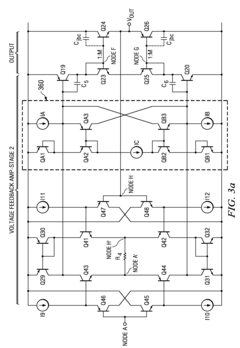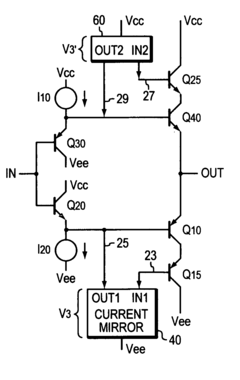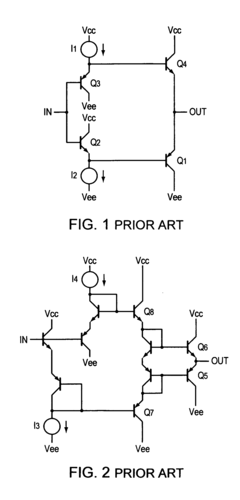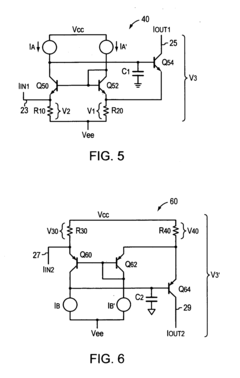How to Achieve Superior Linear Amplification with PNP Transistors?
JUL 28, 20259 MIN READ
Generate Your Research Report Instantly with AI Agent
Patsnap Eureka helps you evaluate technical feasibility & market potential.
PNP Transistor Amplification Background and Objectives
PNP transistors have been a fundamental component in electronic circuits since their inception in the mid-20th century. These devices, characterized by their ability to control current flow using a small input signal, have played a crucial role in the development of analog amplifiers. The quest for superior linear amplification using PNP transistors has been a continuous endeavor in the field of electronics, driven by the ever-increasing demand for high-fidelity audio systems, precision measurement equipment, and advanced communication devices.
The evolution of PNP transistor technology has been marked by significant milestones, from the early germanium-based devices to modern silicon and compound semiconductor implementations. Each advancement has brought improvements in performance, reliability, and efficiency, pushing the boundaries of what is achievable in linear amplification.
The primary objective in achieving superior linear amplification with PNP transistors is to maximize signal fidelity while minimizing distortion across a wide range of operating conditions. This involves addressing several key challenges, including temperature sensitivity, frequency response limitations, and noise reduction. Engineers and researchers have been focusing on optimizing transistor design, improving manufacturing processes, and developing innovative circuit topologies to overcome these hurdles.
One of the critical areas of focus has been the enhancement of transistor linearity, which is essential for maintaining signal integrity in high-performance amplifiers. This has led to the exploration of various biasing techniques, feedback mechanisms, and complementary circuit designs that leverage the unique properties of PNP transistors.
Another important aspect of the technological evolution has been the integration of PNP transistors with other semiconductor devices and passive components to create more sophisticated and efficient amplification systems. This integration has opened up new possibilities for achieving higher levels of performance in compact form factors, suitable for a wide range of applications.
The pursuit of superior linear amplification with PNP transistors is not solely driven by performance metrics but also by practical considerations such as power efficiency, thermal management, and cost-effectiveness. These factors have become increasingly important as electronic devices become more portable and energy-conscious.
As we look towards the future, the goals for PNP transistor-based linear amplification continue to evolve. There is a growing emphasis on achieving wider bandwidth, lower noise figures, and higher linearity at ever-increasing frequencies. Additionally, the integration of PNP transistors into advanced semiconductor processes and novel materials systems presents exciting opportunities for pushing the boundaries of amplifier performance.
The evolution of PNP transistor technology has been marked by significant milestones, from the early germanium-based devices to modern silicon and compound semiconductor implementations. Each advancement has brought improvements in performance, reliability, and efficiency, pushing the boundaries of what is achievable in linear amplification.
The primary objective in achieving superior linear amplification with PNP transistors is to maximize signal fidelity while minimizing distortion across a wide range of operating conditions. This involves addressing several key challenges, including temperature sensitivity, frequency response limitations, and noise reduction. Engineers and researchers have been focusing on optimizing transistor design, improving manufacturing processes, and developing innovative circuit topologies to overcome these hurdles.
One of the critical areas of focus has been the enhancement of transistor linearity, which is essential for maintaining signal integrity in high-performance amplifiers. This has led to the exploration of various biasing techniques, feedback mechanisms, and complementary circuit designs that leverage the unique properties of PNP transistors.
Another important aspect of the technological evolution has been the integration of PNP transistors with other semiconductor devices and passive components to create more sophisticated and efficient amplification systems. This integration has opened up new possibilities for achieving higher levels of performance in compact form factors, suitable for a wide range of applications.
The pursuit of superior linear amplification with PNP transistors is not solely driven by performance metrics but also by practical considerations such as power efficiency, thermal management, and cost-effectiveness. These factors have become increasingly important as electronic devices become more portable and energy-conscious.
As we look towards the future, the goals for PNP transistor-based linear amplification continue to evolve. There is a growing emphasis on achieving wider bandwidth, lower noise figures, and higher linearity at ever-increasing frequencies. Additionally, the integration of PNP transistors into advanced semiconductor processes and novel materials systems presents exciting opportunities for pushing the boundaries of amplifier performance.
Market Demand for High-Quality Linear Amplifiers
The market demand for high-quality linear amplifiers has been steadily growing across various industries, driven by the increasing need for precise signal processing and amplification in numerous applications. In the telecommunications sector, the rollout of 5G networks has created a surge in demand for linear amplifiers capable of handling complex modulation schemes and higher frequency bands. These amplifiers are crucial for maintaining signal integrity and minimizing distortion in wireless communication systems.
The consumer electronics market has also contributed significantly to the demand for superior linear amplifiers. With the rise of high-fidelity audio systems, home theater setups, and premium headphones, consumers are seeking audio equipment that can deliver pristine sound quality. This trend has pushed manufacturers to incorporate advanced linear amplification technologies into their products to meet the discerning needs of audiophiles and music enthusiasts.
In the industrial and scientific sectors, the demand for high-quality linear amplifiers is driven by the need for precise measurement and control systems. Industries such as aerospace, automotive, and semiconductor manufacturing require amplifiers with exceptional linearity and low noise characteristics for applications such as sensor interfaces, test and measurement equipment, and process control systems.
The medical industry has emerged as another significant market for high-quality linear amplifiers. Advanced medical imaging technologies, such as MRI and ultrasound systems, rely on linear amplifiers to process and amplify weak signals accurately. The growing emphasis on early disease detection and non-invasive diagnostic techniques has further fueled the demand for superior amplification solutions in medical equipment.
The automotive sector has also witnessed an increased demand for high-quality linear amplifiers, particularly in the development of electric and autonomous vehicles. These amplifiers play a crucial role in various automotive systems, including advanced driver assistance systems (ADAS), infotainment systems, and battery management systems, where accurate signal processing is essential for safety and performance.
As the Internet of Things (IoT) continues to expand, the need for reliable and efficient communication in connected devices has created new opportunities for linear amplifier manufacturers. IoT applications in smart homes, industrial automation, and environmental monitoring require amplifiers that can operate efficiently across a wide range of frequencies and power levels while maintaining signal integrity.
The ongoing trend towards miniaturization and power efficiency in electronic devices has also influenced the market demand for high-quality linear amplifiers. Manufacturers are increasingly focusing on developing compact, low-power amplifiers that can deliver superior performance without compromising on linearity or signal quality. This trend is particularly evident in portable devices, wearable technology, and battery-powered IoT sensors.
The consumer electronics market has also contributed significantly to the demand for superior linear amplifiers. With the rise of high-fidelity audio systems, home theater setups, and premium headphones, consumers are seeking audio equipment that can deliver pristine sound quality. This trend has pushed manufacturers to incorporate advanced linear amplification technologies into their products to meet the discerning needs of audiophiles and music enthusiasts.
In the industrial and scientific sectors, the demand for high-quality linear amplifiers is driven by the need for precise measurement and control systems. Industries such as aerospace, automotive, and semiconductor manufacturing require amplifiers with exceptional linearity and low noise characteristics for applications such as sensor interfaces, test and measurement equipment, and process control systems.
The medical industry has emerged as another significant market for high-quality linear amplifiers. Advanced medical imaging technologies, such as MRI and ultrasound systems, rely on linear amplifiers to process and amplify weak signals accurately. The growing emphasis on early disease detection and non-invasive diagnostic techniques has further fueled the demand for superior amplification solutions in medical equipment.
The automotive sector has also witnessed an increased demand for high-quality linear amplifiers, particularly in the development of electric and autonomous vehicles. These amplifiers play a crucial role in various automotive systems, including advanced driver assistance systems (ADAS), infotainment systems, and battery management systems, where accurate signal processing is essential for safety and performance.
As the Internet of Things (IoT) continues to expand, the need for reliable and efficient communication in connected devices has created new opportunities for linear amplifier manufacturers. IoT applications in smart homes, industrial automation, and environmental monitoring require amplifiers that can operate efficiently across a wide range of frequencies and power levels while maintaining signal integrity.
The ongoing trend towards miniaturization and power efficiency in electronic devices has also influenced the market demand for high-quality linear amplifiers. Manufacturers are increasingly focusing on developing compact, low-power amplifiers that can deliver superior performance without compromising on linearity or signal quality. This trend is particularly evident in portable devices, wearable technology, and battery-powered IoT sensors.
Current Challenges in PNP Transistor Linear Amplification
Despite the widespread use of PNP transistors in linear amplification circuits, several challenges persist in achieving superior performance. One of the primary issues is the inherent lower mobility of holes compared to electrons, which results in reduced current gain and frequency response in PNP transistors. This limitation often leads to compromised bandwidth and slower switching speeds in amplifier designs.
Another significant challenge is the increased base-width modulation effect in PNP transistors, commonly known as the Early effect. This phenomenon causes variations in the effective base width with changes in collector-emitter voltage, leading to non-linear behavior and reduced output impedance. Consequently, achieving high linearity across a wide range of operating conditions becomes more difficult with PNP transistors.
Temperature sensitivity poses yet another hurdle in PNP transistor linear amplification. The temperature dependence of various transistor parameters, such as current gain and base-emitter voltage, can lead to thermal runaway and instability in high-power applications. This necessitates careful thermal management and compensation techniques, adding complexity to circuit design and potentially limiting the overall performance.
Noise performance is also a concern in PNP transistor amplifiers. The higher base resistance typically found in PNP devices contributes to increased noise figures, particularly at higher frequencies. This can be especially problematic in low-noise applications, where signal integrity is crucial.
Manufacturing inconsistencies and process variations present additional challenges. PNP transistors often exhibit greater parameter spread compared to their NPN counterparts, making it more difficult to achieve consistent performance across different production batches. This variability can lead to yield issues and increased costs in high-volume production scenarios.
Parasitic capacitances, particularly the collector-substrate capacitance in integrated circuit implementations, can limit the high-frequency performance of PNP transistors. These capacitances contribute to reduced bandwidth and increased distortion, especially in applications requiring wide bandwidth or high-speed operation.
Lastly, the design of complementary circuits, which often utilize both NPN and PNP transistors, faces challenges due to the asymmetry in performance characteristics between the two types. Achieving balanced performance and maintaining symmetry in push-pull configurations or other complementary designs requires careful matching and compensation techniques, adding to the complexity of circuit design and potentially limiting the overall system performance.
Another significant challenge is the increased base-width modulation effect in PNP transistors, commonly known as the Early effect. This phenomenon causes variations in the effective base width with changes in collector-emitter voltage, leading to non-linear behavior and reduced output impedance. Consequently, achieving high linearity across a wide range of operating conditions becomes more difficult with PNP transistors.
Temperature sensitivity poses yet another hurdle in PNP transistor linear amplification. The temperature dependence of various transistor parameters, such as current gain and base-emitter voltage, can lead to thermal runaway and instability in high-power applications. This necessitates careful thermal management and compensation techniques, adding complexity to circuit design and potentially limiting the overall performance.
Noise performance is also a concern in PNP transistor amplifiers. The higher base resistance typically found in PNP devices contributes to increased noise figures, particularly at higher frequencies. This can be especially problematic in low-noise applications, where signal integrity is crucial.
Manufacturing inconsistencies and process variations present additional challenges. PNP transistors often exhibit greater parameter spread compared to their NPN counterparts, making it more difficult to achieve consistent performance across different production batches. This variability can lead to yield issues and increased costs in high-volume production scenarios.
Parasitic capacitances, particularly the collector-substrate capacitance in integrated circuit implementations, can limit the high-frequency performance of PNP transistors. These capacitances contribute to reduced bandwidth and increased distortion, especially in applications requiring wide bandwidth or high-speed operation.
Lastly, the design of complementary circuits, which often utilize both NPN and PNP transistors, faces challenges due to the asymmetry in performance characteristics between the two types. Achieving balanced performance and maintaining symmetry in push-pull configurations or other complementary designs requires careful matching and compensation techniques, adding to the complexity of circuit design and potentially limiting the overall system performance.
Existing Solutions for PNP Linear Amplification
01 PNP transistor structure for linear amplification
Specific structural designs of PNP transistors are crucial for achieving linear amplification. These designs focus on optimizing the base, emitter, and collector regions to enhance the transistor's linear response. Techniques such as adjusting doping profiles, layer thicknesses, and junction geometries are employed to improve the device's performance in linear amplification applications.- PNP transistor structure for linear amplification: Specific structural designs of PNP transistors are crucial for achieving linear amplification. These designs focus on optimizing the base, emitter, and collector regions to enhance the transistor's performance in linear amplification applications. Key considerations include doping profiles, layer thicknesses, and junction formations to improve linearity and gain.
- Biasing techniques for PNP transistor amplifiers: Proper biasing is essential for PNP transistors to operate in their linear region for amplification. Various biasing techniques are employed to set the correct operating point, ensuring stable and linear amplification. These methods may include voltage divider biasing, current mirror biasing, or temperature-compensated biasing circuits.
- Feedback mechanisms in PNP linear amplifiers: Feedback mechanisms play a crucial role in maintaining linearity and stability in PNP transistor amplifiers. Negative feedback is commonly used to reduce distortion, improve bandwidth, and stabilize gain. Various feedback topologies, such as voltage-series, current-shunt, or a combination of both, can be implemented to optimize amplifier performance.
- Temperature compensation in PNP linear amplifiers: Temperature variations can significantly affect the performance of PNP transistor amplifiers. Implementing temperature compensation techniques is crucial for maintaining consistent linear amplification across a wide temperature range. These techniques may involve using thermistors, diodes, or specialized circuit designs to counteract temperature-induced variations in transistor characteristics.
- Integration of PNP transistors in linear amplifier ICs: Integrating PNP transistors into linear amplifier integrated circuits (ICs) presents unique challenges and opportunities. Specialized fabrication processes and circuit designs are employed to optimize the performance of PNP transistors within the IC environment. These integrated solutions often incorporate additional features such as current limiting, thermal shutdown, and improved noise characteristics.
02 Biasing techniques for PNP transistor linear amplifiers
Proper biasing is essential for PNP transistors to operate in their linear region. Various biasing techniques are used to set the operating point of the transistor, ensuring it remains in the active region for linear amplification. These methods may include voltage divider biasing, current mirror biasing, or temperature-compensated biasing networks to maintain stable operation across different conditions.Expand Specific Solutions03 Feedback mechanisms in PNP linear amplifiers
Feedback mechanisms play a crucial role in improving the linearity and stability of PNP transistor amplifiers. Negative feedback techniques are commonly employed to reduce distortion, extend bandwidth, and stabilize gain. Various feedback topologies, such as voltage-series, current-series, or a combination of both, are used depending on the specific application requirements.Expand Specific Solutions04 Complementary PNP-NPN configurations for linear amplification
Complementary configurations using both PNP and NPN transistors are often employed to achieve improved linearity and symmetrical operation in amplifier circuits. These configurations can include push-pull output stages, long-tailed pairs, or cascode arrangements. The complementary design helps to cancel out even-order harmonics and reduce crossover distortion, resulting in enhanced linear performance.Expand Specific Solutions05 Temperature compensation in PNP linear amplifiers
Temperature compensation techniques are crucial for maintaining the linear performance of PNP transistor amplifiers across varying operating conditions. These methods may include the use of thermistors, diodes, or specially designed current sources to counteract the effects of temperature on transistor characteristics. Proper temperature compensation ensures consistent gain, bias point stability, and overall linearity of the amplifier circuit.Expand Specific Solutions
Key Players in PNP Transistor Amplifier Industry
The market for PNP transistor linear amplification is in a mature stage, with established players and well-understood technology. The global market size for transistor amplifiers is substantial, driven by demand in consumer electronics, telecommunications, and industrial applications. Technologically, PNP transistor amplification is well-developed, with ongoing incremental improvements. Key players like Texas Instruments, STMicroelectronics, and Infineon Technologies lead in innovation and market share, while companies such as Renesas Electronics and ON Semiconductor offer competitive solutions. Emerging players from China, including Shanghai Belling and Huahong Grace, are increasingly entering the market with cost-effective alternatives, intensifying competition in this mature but still evolving sector.
International Business Machines Corp.
Technical Solution: IBM has developed advanced PNP transistor designs for superior linear amplification. Their approach involves using Silicon-Germanium (SiGe) heterojunction bipolar transistors (HBTs) to achieve high linearity and low noise performance[1]. The company's PNP transistors feature a vertical structure with optimized doping profiles and carefully engineered base-emitter junctions to minimize non-linear effects. IBM's technology also incorporates advanced thermal management techniques to maintain stable performance across a wide temperature range, which is crucial for maintaining linearity in high-power applications[2].
Strengths: High linearity, low noise, and excellent thermal stability. Weaknesses: Potentially higher production costs and complexity compared to standard silicon transistors.
Infineon Technologies AG
Technical Solution: Infineon has developed a range of high-performance PNP transistors for linear amplification applications. Their approach focuses on optimizing the transistor's geometry and doping profiles to achieve high linearity and low distortion. Infineon's PNP transistors feature a proprietary vertical structure that minimizes parasitic capacitances and resistances, resulting in improved frequency response and linearity[3]. The company also employs advanced packaging techniques to enhance thermal dissipation, allowing for higher power handling capabilities while maintaining linear performance[4].
Strengths: Excellent linearity, high-frequency performance, and good power handling. Weaknesses: May be more expensive than standard transistors and require specialized manufacturing processes.
Core Innovations in PNP Transistor Design
High efficiency linear amplifier
PatentInactiveUS7362176B2
Innovation
- A linear amplifier circuit is configured with a voltage feedback amplifier stage driving a totem-pole output stage, incorporating a series arrangement of npn and pnp output transistors with diode-configured bases and a capacitor between the collector and base to reduce conduction during high-frequency signals, minimizing shoot-through and maintaining high gain and linearity.
High output current buffer
PatentInactiveUS20070159255A1
Innovation
- The proposed solution involves a bipolar transistor configuration with a current mirror approach, where the emitter of a second transistor is coupled to the collector of the first transistor, and a feedback loop is formed with additional transistors to reduce quiescent power dissipation while maintaining high output current and dynamic range, using a configuration similar to U.S. Pat. No. 4,574,233 but with distinct differences.
Thermal Management in PNP Linear Amplifiers
Thermal management is a critical aspect of designing high-performance PNP linear amplifiers. As power dissipation increases in these devices, effective heat removal becomes essential to maintain optimal performance and reliability. The primary challenge lies in managing the heat generated by the transistor junction, which can lead to thermal runaway if not properly addressed.
One of the key strategies for thermal management in PNP linear amplifiers is the use of heat sinks. These components are designed to increase the surface area available for heat dissipation, allowing for more efficient cooling through convection and radiation. The selection of an appropriate heat sink depends on factors such as the power dissipation of the amplifier, ambient temperature, and available space. Thermal interface materials, such as thermal paste or pads, are often used to improve heat transfer between the transistor package and the heat sink.
Another important consideration is the layout and design of the printed circuit board (PCB). Proper thermal design of the PCB can significantly enhance heat dissipation. This includes using thicker copper layers, implementing thermal vias to conduct heat away from critical components, and strategically placing components to optimize airflow. In some cases, multi-layer PCBs with dedicated thermal layers can be employed to further improve heat distribution.
Active cooling methods, such as forced-air cooling or liquid cooling, may be necessary for high-power applications. Fans or blowers can be used to increase air circulation around the amplifier, while liquid cooling systems offer even greater heat dissipation capabilities for the most demanding applications. However, these active cooling solutions often come with trade-offs in terms of cost, complexity, and potential reliability issues.
Temperature sensing and thermal protection circuits are crucial for ensuring the long-term reliability of PNP linear amplifiers. These circuits can monitor the temperature of critical components and adjust the amplifier's operation or shut it down if thermal limits are exceeded. Implementing such protection mechanisms helps prevent catastrophic failures due to overheating and extends the operational lifespan of the amplifier.
Careful consideration of the amplifier's operating environment is also essential. Factors such as ambient temperature, altitude, and enclosure design can significantly impact thermal performance. Proper ventilation and airflow management within the enclosure are critical for maintaining acceptable operating temperatures. In some cases, the use of thermally conductive enclosures or additional external heat sinking may be necessary to achieve optimal thermal management.
One of the key strategies for thermal management in PNP linear amplifiers is the use of heat sinks. These components are designed to increase the surface area available for heat dissipation, allowing for more efficient cooling through convection and radiation. The selection of an appropriate heat sink depends on factors such as the power dissipation of the amplifier, ambient temperature, and available space. Thermal interface materials, such as thermal paste or pads, are often used to improve heat transfer between the transistor package and the heat sink.
Another important consideration is the layout and design of the printed circuit board (PCB). Proper thermal design of the PCB can significantly enhance heat dissipation. This includes using thicker copper layers, implementing thermal vias to conduct heat away from critical components, and strategically placing components to optimize airflow. In some cases, multi-layer PCBs with dedicated thermal layers can be employed to further improve heat distribution.
Active cooling methods, such as forced-air cooling or liquid cooling, may be necessary for high-power applications. Fans or blowers can be used to increase air circulation around the amplifier, while liquid cooling systems offer even greater heat dissipation capabilities for the most demanding applications. However, these active cooling solutions often come with trade-offs in terms of cost, complexity, and potential reliability issues.
Temperature sensing and thermal protection circuits are crucial for ensuring the long-term reliability of PNP linear amplifiers. These circuits can monitor the temperature of critical components and adjust the amplifier's operation or shut it down if thermal limits are exceeded. Implementing such protection mechanisms helps prevent catastrophic failures due to overheating and extends the operational lifespan of the amplifier.
Careful consideration of the amplifier's operating environment is also essential. Factors such as ambient temperature, altitude, and enclosure design can significantly impact thermal performance. Proper ventilation and airflow management within the enclosure are critical for maintaining acceptable operating temperatures. In some cases, the use of thermally conductive enclosures or additional external heat sinking may be necessary to achieve optimal thermal management.
Noise Reduction Strategies for PNP Amplifiers
Noise reduction is a critical aspect of achieving superior linear amplification with PNP transistors. Various strategies can be employed to minimize noise and enhance the overall performance of PNP amplifiers. One effective approach is the implementation of careful circuit design techniques, such as proper component selection and layout optimization.
Selecting low-noise PNP transistors with high current gain (hFE) and low base-emitter voltage (VBE) can significantly reduce noise levels. Additionally, using high-quality, low-noise resistors and capacitors in the amplifier circuit can help minimize thermal noise and other unwanted signal distortions.
Proper biasing of the PNP transistor is crucial for noise reduction. Implementing a stable bias network that maintains consistent operating conditions across temperature variations can help minimize noise introduced by fluctuations in the transistor's operating point. This can be achieved through the use of temperature-compensated bias circuits or active bias control mechanisms.
Shielding and isolation techniques play a vital role in noise reduction for PNP amplifiers. Employing proper shielding methods, such as using metal enclosures or ground planes, can help protect the amplifier circuit from external electromagnetic interference (EMI) and radio frequency interference (RFI). Additionally, careful routing of signal paths and power supply lines can minimize crosstalk and ground loop issues.
Implementing feedback mechanisms can also contribute to noise reduction in PNP amplifiers. Negative feedback, when properly applied, can help reduce distortion and improve the overall signal-to-noise ratio (SNR) of the amplifier. This technique involves feeding a portion of the output signal back to the input, effectively canceling out noise and non-linearities introduced by the amplifier.
Power supply decoupling and filtering are essential strategies for minimizing noise in PNP amplifiers. Utilizing high-quality bypass capacitors and implementing proper power supply filtering techniques can help reduce power supply ripple and noise that may otherwise couple into the amplifier circuit.
Advanced noise reduction techniques, such as chopper stabilization or auto-zeroing, can be employed in high-precision PNP amplifier designs. These methods effectively modulate the input signal to shift the noise spectrum to higher frequencies, where it can be more easily filtered out.
By combining these noise reduction strategies and tailoring them to the specific requirements of the PNP amplifier design, it is possible to achieve superior linear amplification with minimal noise interference. Careful consideration of these techniques during the design and implementation phases can result in high-performance PNP amplifiers suitable for a wide range of applications.
Selecting low-noise PNP transistors with high current gain (hFE) and low base-emitter voltage (VBE) can significantly reduce noise levels. Additionally, using high-quality, low-noise resistors and capacitors in the amplifier circuit can help minimize thermal noise and other unwanted signal distortions.
Proper biasing of the PNP transistor is crucial for noise reduction. Implementing a stable bias network that maintains consistent operating conditions across temperature variations can help minimize noise introduced by fluctuations in the transistor's operating point. This can be achieved through the use of temperature-compensated bias circuits or active bias control mechanisms.
Shielding and isolation techniques play a vital role in noise reduction for PNP amplifiers. Employing proper shielding methods, such as using metal enclosures or ground planes, can help protect the amplifier circuit from external electromagnetic interference (EMI) and radio frequency interference (RFI). Additionally, careful routing of signal paths and power supply lines can minimize crosstalk and ground loop issues.
Implementing feedback mechanisms can also contribute to noise reduction in PNP amplifiers. Negative feedback, when properly applied, can help reduce distortion and improve the overall signal-to-noise ratio (SNR) of the amplifier. This technique involves feeding a portion of the output signal back to the input, effectively canceling out noise and non-linearities introduced by the amplifier.
Power supply decoupling and filtering are essential strategies for minimizing noise in PNP amplifiers. Utilizing high-quality bypass capacitors and implementing proper power supply filtering techniques can help reduce power supply ripple and noise that may otherwise couple into the amplifier circuit.
Advanced noise reduction techniques, such as chopper stabilization or auto-zeroing, can be employed in high-precision PNP amplifier designs. These methods effectively modulate the input signal to shift the noise spectrum to higher frequencies, where it can be more easily filtered out.
By combining these noise reduction strategies and tailoring them to the specific requirements of the PNP amplifier design, it is possible to achieve superior linear amplification with minimal noise interference. Careful consideration of these techniques during the design and implementation phases can result in high-performance PNP amplifiers suitable for a wide range of applications.
Unlock deeper insights with Patsnap Eureka Quick Research — get a full tech report to explore trends and direct your research. Try now!
Generate Your Research Report Instantly with AI Agent
Supercharge your innovation with Patsnap Eureka AI Agent Platform!
